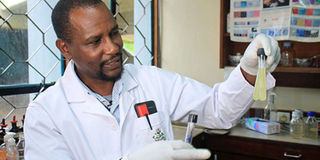Retracing the ‘Toxic Flow’ exposé

Dr Nduhiu Gitahi, principal technologist in charge of laboratories at the University of Nairobi’s Public Health, Pharmacology and Toxicology department, shows one of the samples collected during the river pollution investigative project by the Nation Media Group, at his office on July 21, 2019. Forty-nine samples were collected. PHOTO | FILE | NATION MEDIA GROUP
What you need to know:
- Our sampling points were Ondiri springs in Kikuyu, Ndwaru, or Satellite, near Kawangware and Chiromo at the Museum Hill interchange near the Nairobi Museum.
- We tested for the presence of 12 different metals of toxicological importance using the East African standard known as procedure 67.
The two-month river pollution investigative project, “Toxic Flow”, started with mapping out the entire river and breaking it down into sections depending on the intensity of human activity.
We spent days researching the tributaries through its 390-kilometre journey as it traverses several counties to the Kenyan coast.
We trailed the river from Kiambu County where it starts, through Nairobi, Machakos, Makueni, Taita Taveta and Kilifi counties, until it exited into the Indian Ocean at Sabaki Bridge.
A team of scientists from the University of Nairobi helped us narrow down our investigation by selecting 10 sampling points on the river, which tells its whole story.
From these points, we collected 49 samples comprising water, sediments, fish, vegetables, crabs and other aquatic animals.
The sampling points represented the major anthropogenic activities along the river, mainly agricultural and industrial.
SAMPLE POINTS
Our sampling points were Ondiri springs in Kikuyu, Ndwaru or Satellite near Kawangware and Chiromo at the Museum Hill interchange near the Nairobi Museum.
The other points were Gikomba, Dandora dumpsite, and Pipeline near the bridge on Outer Ring road.
The next sample was picked at Thwake Makueni County, from where the river is being diverted to harvest water for the Sh82 billion dam.
The last two points were in Malindi near Sabaki Bridge, where the river ends.
As we picked the samples, we recorded the exact GPS coordinates of every sampling point using a smart phone.
We picked four water samples at each of the 10 sampling points to make the sample collection watertight.
ANALYSES
The samples were aseptically obtained in pre-sterilised water-sampling containers for microbial quality.
We also collected an extra sample in a plastic container for physiochemical analysis. At every sampling point, the pH and temperature of the river water were obtained in situ.
We transported our samples in coolers to the University of Nairobi’s Public Health, Pharmacology and Toxicology (PHPT) laboratories for analyses.
The samples in Malindi were flown to Nairobi to make sure they arrived within eight hours of sample collection and testing, as was the rest of the samples.
The lead researcher was Prof James Mbaria, the chairman of the PHPT department. Dr Nduhiu Gitahi, the principal technologist in charge of laboratories at the department, assisted him.
The microbial water quality was analysed within six hours of sampling and results recorded.
PARAMETERS
Physiochemical analysis was carried out after all the samples were obtained. Sediments and fish, where available, were also sampled for chemical analysis.
We tested for the presence of 12 different metals of toxicological importance using the East African standard known as procedure 67.
These were mercury, chromium, arsenic, cadmium, lead, selenium, copper, zinc, manganese, aluminium and barium.
The testing method used is known as the Atomic Absorption Spectrophotometric (AAS).
We also analysed the metals according to the standards set by the National Environment Management Authority (Nema), using the spectrophotometry methods.
We tested the water for bacteria according to Kenyan standards.
The parameters used were the total coliforms, total fecal streptococcus and Escherichia coli. It would take a month before the complete results of the tests were out.





